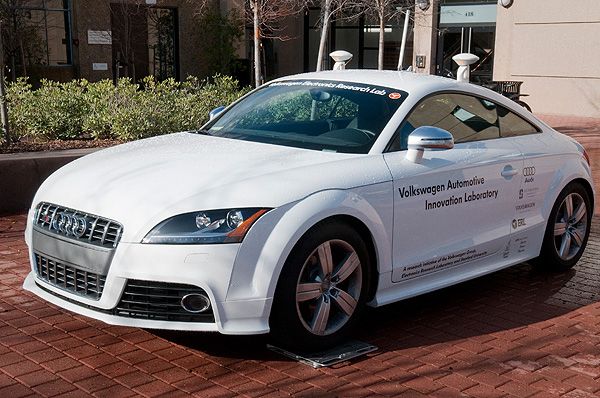Some people may remember when Michelle Mouton became the first woman ever to win the Pikes Peak International Hill Climb back in 1984. Other people not only remember it, but decide to honor her achievement by naming a very special car after her. This car is a white Audi TTS befittingly named “Shelley”, after Michelle Mouton herself, mechanically engineered to drive by itself. Yes, I mean without a driver.
Chris Gerdes is the program director for the Center for Automotive Research at Stanford (CARS, cute huh?) and a professor of mechanical engineering. He and his Dynamic Design Lab consisting of graduates and PhDs have been working on “Shelley” for the past few years and are close in attaining their goal of sending her up the Colorado mountain without a driver.
“How can they do it,” you ask? Hit the jump to find out.
Chris Gerdes and his team have been working on robotic cars for years and have successfully built two self-driven vehicles before “Shelley”. The first was “Stanley”, a Volkswagen Touareg->ke321 that won the 2005 Grand Challenge in the Mojave Desert and the second was “Junior”, a Volkswagen Passat->ke224 that came in second at the Defense Advanced Research Projects Agency’s (DARPA) 2007 Urban Challenge. Both of these vehicles were successful in these races due to a radars and cameras that would sense the road. “Shelley” has neither camera nor radars. “Shelley” will be making the climb up Pikes Peak following a trail outlined in her GPS system. This GPS system is teamed up with another system that determines speed and sideways motion enabling it to control the car’s direction when the GPS can’t connect to its satellites. It also provides prompt updates on the car’s position.
Unfortunately, “Shelley” is not ready for the climb just yet. Apparently, the vehicle can operate smoothly up until it hits speeds of 130mph. That is when the GPS system starts giving the researchers problems.
"Our first goal is to go up Pikes Peak at speeds resembling race speeds, keep the car stable around the corners and have everything work the way we want it to," said Chris Gerdes, program director of CARS and leader of the graduate research team. "We're not going to put it on the mountain until we can do it safely."
Gerdes and his team are currently working to perfect making turns as fast as possible, braking at the last possible minute, and accelerating as soon as they’re steering out of a turn.
"Our goal is to show that we can do this," Gerdes said. "There are some sheer drops at Pikes Peak in which any sort of self-preservation kicks in and you slow down a bit. We want to go up at the speed that few normal drivers would ever think of attempting."
The whole idea of a car that drives itself is pretty scary, albeit very cool. If they are successful, it can open the doors to so many possibilities. It could even eliminate the need to have the race car driver in the car thus eliminating injury or even death. Could we call it racing? Probably not. This would end up being the nerdy version of race car driving; good for technological advancement, bad for testosterone levels.

